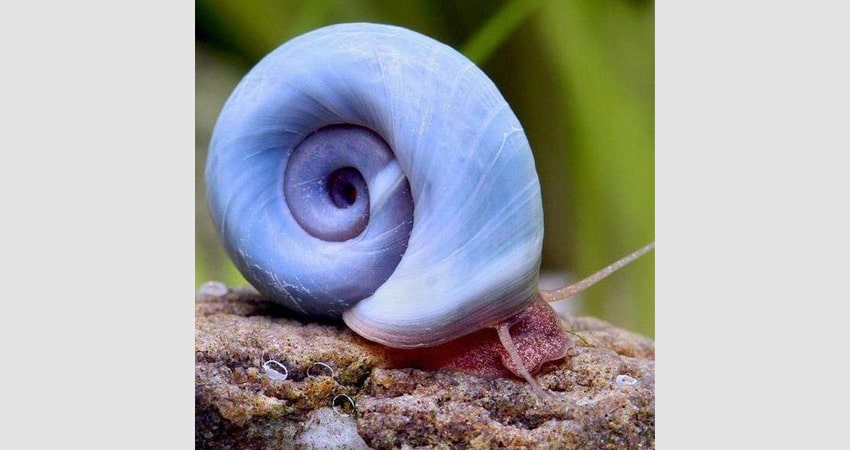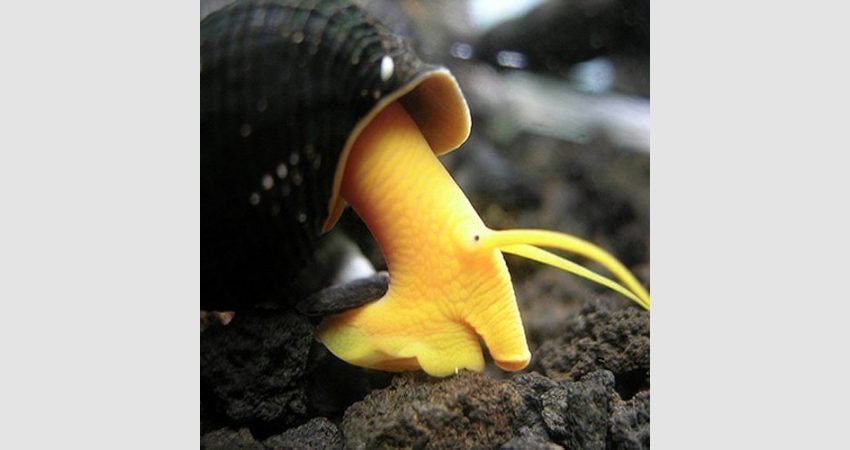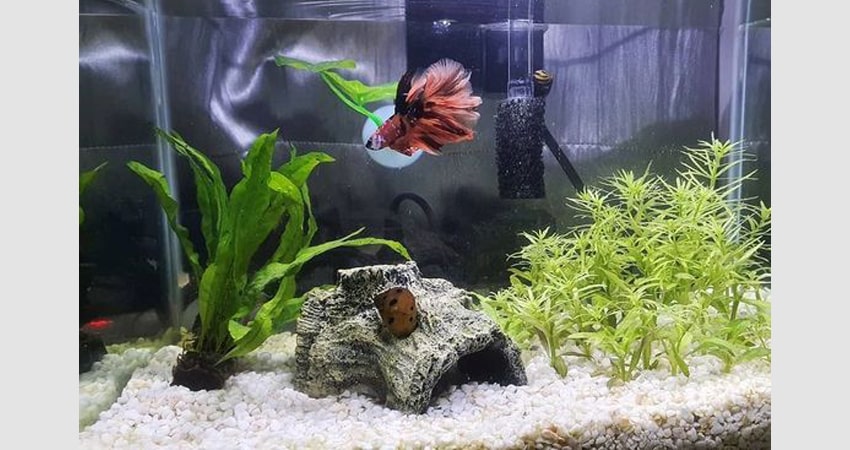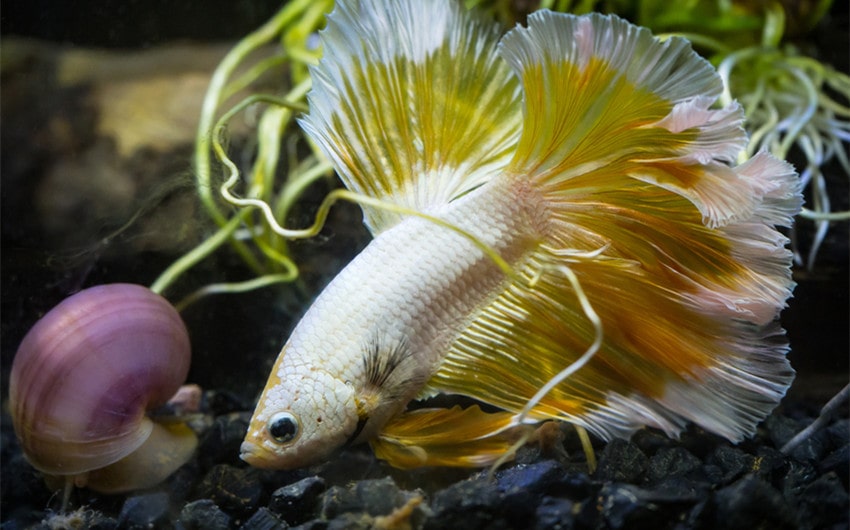Can Betta Fish Live with Snails? Tips for Peaceful Coexistence
If you’re thinking about adding snails to your betta fish tank, you might be wondering, can betta fish live with snails? The good news is, yes, betta fish can live peacefully with snails, as long as you choose the right species and set up your tank properly. Snails can be great companions for bettas, helping to keep the tank clean while adding a unique touch to your aquarium. However, it’s important to understand your betta’s behavior and select compatible snails to ensure a harmonious environment. Let’s dive into what you need to know for a successful betta and snail pairing!
Understanding Betta Fish Behavior
Betta fish, also known as Siamese fighting fish, are renowned for their vibrant colors and striking personalities, but they are also known for their territorial and sometimes aggressive nature. In the wild, bettas are solitary creatures that fiercely protect their space from rivals, which is why they are often housed alone in tanks. Their strong predatory instincts can lead them to view smaller tank mates, including snails, as potential intruders or prey. However, not all bettas are equally aggressive; individual temperament plays a big role, and some bettas can be surprisingly calm and tolerant of other tank inhabitants.
Bettas are also highly curious and intelligent, often investigating new additions to their environment, which may initially include nipping at snails. However, once accustomed to the presence of snails, many bettas lose interest and can coexist peacefully. Providing hiding spots, plants, and visual barriers can help minimize territorial behavior, creating a calmer environment. By understanding your betta’s unique personality and observing how it interacts with its surroundings, you can better determine if your betta will get along with snails, making for a more harmonious tank setup.
Benefits of Keeping Snails with Betta Fish
Adding snails to your betta fish tank can bring a host of advantages that enhance both the cleanliness and overall harmony of the aquarium. Here are some key benefits of keeping snails with your betta fish:
1. Natural Tank Cleaners
One of the biggest benefits of keeping snails in a betta tank is their ability to help maintain a clean environment. Snails feed on algae, leftover food, and other debris that can accumulate in the tank, keeping the walls, substrate, and plants looking fresh. By consuming waste, snails play a crucial role in maintaining water quality, reducing the buildup of harmful substances that can negatively impact your betta’s health. This cleaning service helps reduce the need for frequent manual cleaning and keeps the tank in optimal condition.
2. Low-Maintenance and Peaceful Companions
Snails are low-maintenance creatures that require little attention beyond basic care, making them easy to manage alongside your betta. Unlike other potential tank mates, snails do not compete for food or provoke territorial behavior, allowing your betta to continue its routine without stress. Snails move slowly and spend most of their time grazing on surfaces, making them less likely to be seen as a threat by your betta. Their calm, non-intrusive nature helps create a peaceful environment, contributing to the overall well-being of both the snail and the fish.
3. Added Visual Appeal and Interest
Snails can also enhance the aesthetic appeal of your aquarium. With their unique shells and slow, deliberate movements, snails like Nerite and Mystery snails add an interesting dynamic to the tank’s visual landscape. Their various colors and patterns provide an extra element of beauty that complements the vivid colors of your betta. This added visual diversity creates a more engaging and attractive setup that can make your tank a true centerpiece.
4. Natural Aeration and Tank Health
As snails move through the tank, they naturally aerate the substrate, which helps prevent the buildup of harmful gases that can form under the surface. This movement improves the overall health of the tank’s ecosystem, ensuring a balanced environment for all inhabitants. By contributing to the natural cycle of the aquarium, snails help maintain a healthy habitat that benefits your betta fish and keeps the tank functioning smoothly.
5. Stress Reduction for Betta Fish
The presence of snails can have a calming effect on your betta fish. Because snails are non-aggressive and occupy themselves with cleaning, they pose no threat to the betta, allowing it to feel more secure in its space. This peaceful coexistence can reduce stress levels in your betta, which is important for maintaining its health and preventing aggressive behaviors that may arise from loneliness or boredom. A less stressed betta is generally more vibrant, active, and healthy.
Best Snail Species to Keep with Betta Fish
Choosing the right snail species to keep with your betta fish is crucial to ensure a harmonious and balanced tank environment. Not all snails are suitable companions for bettas, as some species may grow too large, reproduce excessively, or become targets of your betta’s curiosity. However, several species are well-suited to living with bettas due to their peaceful nature, manageable size, and beneficial habits. Here are some of the best snail species that can thrive alongside your betta fish:
1. Nerite Snails

Image Source: Pinterest
Nerite snails are one of the most popular choices for betta tanks due to their algae-eating capabilities and beautiful shell patterns. Available in various colors, including zebra, tiger, and olive, Nerite snails add an attractive touch to your aquarium. They are excellent algae cleaners, constantly grazing on the glass, plants, and substrate, keeping the tank spotless.
Nerite snails are also non-invasive, meaning they won’t overpopulate your tank as they require brackish water to reproduce. This makes them an ideal low-maintenance companion for bettas, contributing to a cleaner and healthier environment without the worry of an exploding snail population.
2. Mystery Snails
Mystery snails, known for their larger size and striking shell colors, are another great option for betta tanks. These snails are peaceful and slow-moving, spending most of their time exploring the tank and cleaning up leftover food and algae.
Mystery snails come in a variety of vibrant colors, including gold, blue, and ivory, adding a unique visual element to your aquarium. They are relatively easy to care for and can coexist well with bettas if provided with adequate space and hiding spots. It’s important to monitor food availability, as hungry mystery snails may occasionally nibble on live plants, though they generally prefer algae and other debris.
3. Malaysian Trumpet Snails

Image Source: Pinterest
Malaysian Trumpet Snails (MTS) are small, hardy snails known for their ability to burrow into the substrate, aerating it and preventing harmful gas buildup. This natural behavior helps maintain a healthy tank environment, making them beneficial companions for bettas. Malaysian Trumpet Snails are nocturnal, meaning they are most active at night, which reduces the chances of unwanted interactions with your betta during the day. However, they can reproduce quickly, so it’s essential to monitor their population and avoid overfeeding, as excess food can lead to a snail boom.
4. Assassin Snails
Assassin snails are unique among snails as they are carnivorous, feeding on other snails and leftover food. While this might sound intimidating, they are actually quite peaceful toward fish and can help control pest snail populations in your tank. Their striking striped shells make them an attractive addition to any aquarium. Assassin snails are slow-moving and typically won’t provoke your betta, making them a good match. However, they should be introduced with caution if you already have other snail species in the tank, as they may target smaller snails as prey.
5. Ramshorn Snails

Image Source: Pinterest
Ramshorn snails are small, spiral-shelled snails that are great for keeping your tank clean. They feed on algae, leftover food, and decaying plant matter, helping to maintain water quality. Ramshorn snails are generally peaceful and easy to care for, making them a popular choice for beginners.
However, they can reproduce rapidly under ideal conditions, so it’s important to manage their population through controlled feeding and regular maintenance. Despite their potential to multiply, Ramshorn snails are usually left alone by bettas, as their small size and unobtrusive behavior make them low-profile tank mates.
6. Pond Snails
Pond snails are another option for those looking to add snails to their betta tank. They are hardy, adaptable, and efficient cleaners, feeding on algae and leftover food. However, pond snails are notorious for their rapid reproduction, which can quickly lead to an overpopulated tank if not managed carefully. While they are compatible with bettas in terms of behavior, it’s essential to keep an eye on their numbers to prevent them from becoming a nuisance. They are best suited for larger tanks where their population can be more easily controlled.
7. Ivory Snails
Ivory snails are a type of mystery snail with a beautiful pale shell that stands out against the backdrop of any aquarium. They are peaceful, slow movers that mind their own business, making them excellent companions for bettas. Like other snails, they help keep the tank clean by consuming algae and uneaten food, contributing to the overall health of the environment. Their serene presence and unique color add a touch of elegance to your tank setup, making them a lovely addition.
8. Bladder Snails
Bladder snails are small, hardy snails that can be a good fit for a betta tank due to their cleaning capabilities. They thrive on algae, decaying plant matter, and leftover food, helping to keep the tank clean and reduce waste buildup. However, like pond snails, they are prolific breeders and can quickly overpopulate if not managed carefully. Bladder snails are generally peaceful and won’t disturb your betta, but it’s important to monitor their numbers to ensure they don’t overwhelm the tank.
9. Rabbit Snails

Image Source: Pinterest
Rabbit snails are larger, unique snails known for their distinctive long, cone-shaped shells and rabbit-like face. They are peaceful and slow-moving, making them compatible with bettas. Rabbit snails are great algae eaters and can add an interesting dynamic to your aquarium with their unusual appearance and behavior. They are less likely to breed prolifically compared to smaller snails, making them easier to manage in terms of population control.
10. Japanese Trapdoor Snails
Japanese Trapdoor Snails are hardy, attractive snails that are excellent at keeping tanks clean. They are known for their slow reproduction rate, which makes them less likely to overpopulate compared to other snail species. These snails are non-aggressive and spend most of their time cleaning surfaces in the tank, contributing to a healthy aquatic environment. Their beautiful spiral shells add a decorative element to your tank, and their calm demeanor makes them a great match for bettas.
Potential Challenges and How to Mitigate Them
While keeping snails with betta fish can be rewarding, there are some potential challenges to be aware of to ensure a peaceful coexistence. One common issue is that bettas, with their naturally curious and sometimes territorial nature, may nip at or harass snails, especially if they are not accustomed to sharing their space. This behavior can stress both the betta and the snails, leading to an unhealthy environment.
To mitigate this, it’s important to monitor your betta’s behavior closely when introducing snails. Consider starting with a single snail and observe how your betta reacts before adding more. Providing plenty of hiding spots and decorations can also help snails escape unwanted attention.
Another challenge is the potential for overpopulation, especially with species like Malaysian Trumpet Snails, Ramshorn Snails, or Pond Snails that can reproduce rapidly under optimal conditions. Overpopulation can lead to increased waste, poor water quality, and competition for food.
To manage snail populations, avoid overfeeding your betta, as excess food can fuel snail reproduction. Regular tank maintenance, including gravel vacuuming and manual removal of excess snails, can help keep populations under control. Additionally, introducing snail-eating species like Assassin Snails can help manage pest snails naturally without disturbing the betta.
Tank cleanliness can also be a concern, as snails produce waste that contributes to the overall bioload of the tank. If not properly managed, this can affect water quality, leading to issues like ammonia spikes that are harmful to both snails and bettas. To mitigate this, maintain a regular cleaning schedule that includes partial water changes, substrate cleaning, and monitoring water parameters. Adding a good filtration system that can handle the increased bioload and keeping a balanced feeding routine will also help maintain optimal water quality.

Image Source: Pinterest
Tank Setup Tips for Betta and Snail Coexistence
Creating a tank environment that supports both betta fish and snails is key to ensuring a harmonious living space. A properly set up tank will not only minimize potential conflicts but also provide both species with the best conditions for health and well-being. One of the first considerations is tank size; while bettas can live in smaller tanks, adding snails increases the bioload, making a larger tank of at least 5-10 gallons ideal. This additional space allows both the betta and snails to explore without feeling overcrowded, reducing territorial behavior from the betta.
Providing plenty of hiding spots and decorations is crucial for snail survival in a betta tank. Snails need areas where they can retreat if the betta becomes overly curious or aggressive. Adding live or silk plants, driftwood, and small caves not only creates a more natural environment but also offers refuge for snails. Plants like Java fern, Anubias, and moss balls are excellent choices that provide cover and contribute to the tank’s health by absorbing nitrates and offering oxygen. These plants also create visual barriers, helping to break up the betta’s line of sight and reduce territorial aggression.
Lighting and water parameters are also important factors to consider when setting up your tank. Bettas and snails both thrive in similar conditions, but stable water quality is essential. Ensure your tank is equipped with a gentle filter that provides adequate water flow without overwhelming your betta. A filter with adjustable flow settings is ideal, as snails also prefer low to moderate flow environments. Keep the water temperature between 75-80°F (24-27°C) and maintain a pH level around neutral (6.5-7.5), which suits both bettas and most snail species.
It’s also essential to maintain a balanced feeding routine. Bettas are carnivores and need protein-rich foods, while snails feed primarily on algae and detritus. Overfeeding your betta can lead to leftover food that encourages snail overpopulation, so be mindful of portion sizes. You can supplement snail diets with algae wafers or blanched vegetables like zucchini and spinach, but feed sparingly to avoid impacting water quality. Remove any uneaten food promptly to prevent it from decaying and causing spikes in ammonia levels.
Finally, regular water testing and maintenance are crucial for ensuring a healthy environment for both bettas and snails. Perform weekly water changes of 20-30% to keep the water clean and balanced. Test water parameters regularly, checking for ammonia, nitrite, and nitrate levels to ensure they remain safe. A well-maintained tank setup, combined with close observation of your betta’s behavior and snail health, will help create a thriving aquatic community where both species can coexist peacefully.







